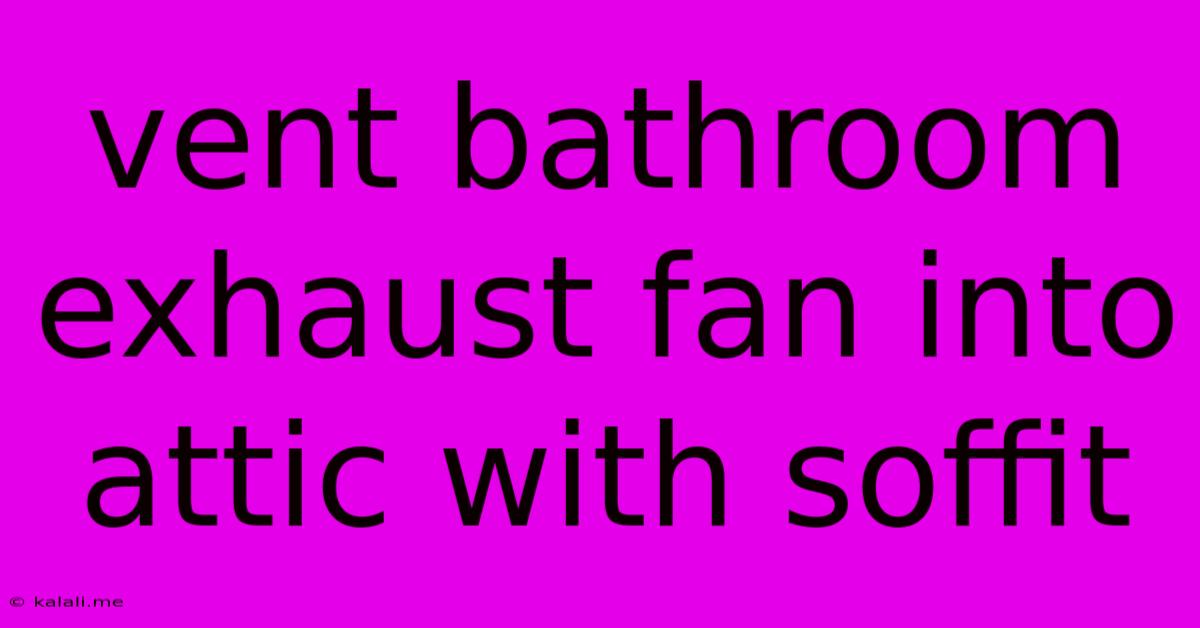Vent Bathroom Exhaust Fan Into Attic With Soffit
Kalali
May 23, 2025 · 3 min read

Table of Contents
Venting a Bathroom Exhaust Fan into the Attic with Soffit: A Comprehensive Guide
Venting a bathroom exhaust fan into the attic and then out through a soffit is a viable option, especially in situations where venting directly to the outside is impractical. However, it's crucial to understand the potential drawbacks and ensure proper installation to avoid moisture problems and code violations. This guide will walk you through the process, highlighting critical considerations for a successful and safe installation.
Why Vent Through the Attic and Soffit?
Sometimes, directly venting a bathroom exhaust fan to the exterior is impossible due to structural limitations, aesthetic concerns, or complex roofing systems. Venting into the attic and then exhausting through a soffit offers a practical alternative. However, this method necessitates careful planning and execution to prevent moisture buildup in the attic, which can lead to mold growth, structural damage, and reduced energy efficiency.
Key Considerations Before You Begin:
- Local Building Codes: Always check your local building codes before starting any plumbing or ventilation project. Codes vary by region and specify requirements for attic ventilation, exhaust fan capacity, and proper venting techniques.
- Attic Ventilation: Adequate attic ventilation is paramount. Insufficient ventilation can trap moisture from the bathroom exhaust, leading to serious problems. Ensure you have sufficient soffit and ridge vents to promote airflow. Consider adding additional ventilation if necessary.
- Insulation: Proper insulation is crucial to prevent moisture condensation. Consider using moisture-resistant insulation in areas near the exhaust vent to minimize the risk of damage.
- Fan Capacity: The exhaust fan should have sufficient CFM (cubic feet per minute) to effectively remove moisture from the bathroom. Undersized fans can lead to moisture buildup.
- Ductwork: Use rigid, non-flexible ductwork whenever possible to prevent air leaks and maintain proper airflow. Seal all joints meticulously.
- Soffit Venting: Ensure the soffit vent is appropriately sized and positioned to allow for adequate exhaust.
Step-by-Step Installation Guide:
- Plan the Route: Carefully plan the ductwork route from the bathroom exhaust fan to the soffit vent, minimizing bends and ensuring adequate slope for efficient airflow.
- Install the Ductwork: Securely attach the rigid ductwork, ensuring all joints are sealed tightly with mastic sealant to prevent air leaks. Maintain a slight upward slope to prevent condensation from pooling.
- Install the Soffit Vent: Cut a hole in the soffit to accommodate the vent. Install the vent, ensuring a tight seal to prevent air leakage. This usually involves using a flashing kit designed to prevent moisture ingress.
- Connect the Ductwork to the Vent: Connect the ductwork to the soffit vent, ensuring a secure and airtight connection.
- Test the System: Turn on the exhaust fan and inspect the entire system for leaks. Check for proper airflow and ensure the fan is operating effectively.
- Regular Maintenance: Regularly inspect and clean the exhaust fan and ductwork to prevent clogs and ensure optimal performance.
Potential Drawbacks:
- Moisture Buildup: The most significant risk is moisture accumulation in the attic. Careful planning and adequate ventilation are crucial to mitigate this.
- Odor Transfer: If not properly sealed, odors from the bathroom could be transferred to other areas of the attic.
- Code Compliance: Failure to meet local building codes can lead to fines or legal issues.
Alternatives to consider:
If venting through the attic and soffit presents too many challenges, explore alternative methods such as venting directly through the exterior wall or roof. Consult with a qualified HVAC professional for a tailored solution.
By carefully following these guidelines and addressing the potential drawbacks, you can successfully vent your bathroom exhaust fan into the attic and through a soffit, providing effective moisture removal while complying with building codes. Remember, consulting with a qualified professional is always recommended for complex installations or if you are unsure about any aspect of the process.
Latest Posts
Latest Posts
-
How Long To Preheat Oven To 400
May 23, 2025
-
Water Heater Leaking From Relief Valve
May 23, 2025
-
To Whom It May Concern In Spanish
May 23, 2025
-
Moment Generating Function Of Normal Distribution
May 23, 2025
-
How To Cut Vinyl Plank Flooring
May 23, 2025
Related Post
Thank you for visiting our website which covers about Vent Bathroom Exhaust Fan Into Attic With Soffit . We hope the information provided has been useful to you. Feel free to contact us if you have any questions or need further assistance. See you next time and don't miss to bookmark.